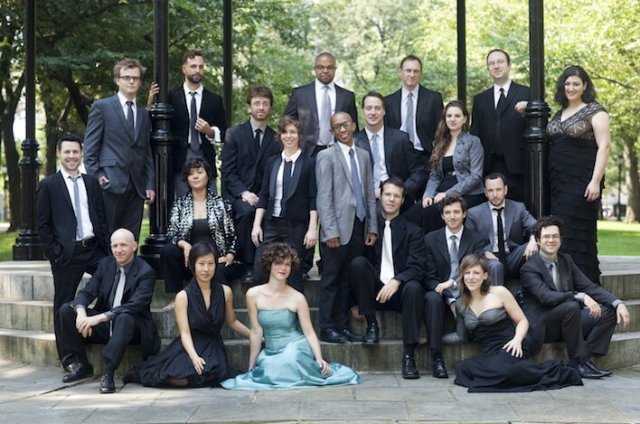
Now in his second season as Music Director of the Seattle Symphony, Ludovic Morlot is making his mark with creative remixes of the traditional symphony concert program. His programming blends repertoire from different ends of the classical music universe into fresh, inventive concerts that juxtapose new and old.
This weekend’s line-up of concerts is no exception. Morlot and the Symphony are collaborating with members of the International Contemporary Ensemble (ICE) on a handful of century-hopping performances that span the past four hundred years of Western music.
Last night’s concert at Benaroya Hall kicked off the weekend’s festivities. The hot ticket of the evening was the world premiere of Mina, a work by 35-year-old composer Dai Fujikura. Commissioned by the Seattle Symphony, the orchestral piece features six solo parts written in collaboration with members of ICE. Fujikura’s choice of solo instruments is an unusual blend of winds and percussion. The standard woodwind quartet of flute, oboe, clarinet, and bassoon is joined by French horn and dulcimer. In addition, the soloists take turns playing a variety of percussion instruments, including bells, chimes, and drums. This instrumentation allows for a myriad of sonic possibilities, of which Fujikura takes full advantage throughout the piece.

Inspired by the birth of his daughter, the piece’s namesake, Mina evokes the relationship between a newborn infant (portrayed by the six soloists) and her parents (represented by the orchestra). Like the rapidly changing expressions on an infant’s face, the soloists’ parts feature abrupt shifts in timbre, tempo, and mood. The orchestra enters into this cloud of sound seamlessly, echoing and supporting the soloists.
Fujikura likens this relationship to the image of protective parents caring for a newborn child. “The orchestra’s role is to surround the soloists, almost like parents do to their children; they react, sometimes initiate the reaction”. This layering of solo and orchestral sounds is particularly effective in a section that blends gentle rhythmic patterns on the dulcimer with a similarly calm melody played by the full string section.
In the middle of the piece, the orchestra fades away and Fujikura brings the audience’s focus to the group of soloists. This cadenza-like interlude, representing the dreams of a newborn child, features bass flute, prepared dulcimer, and a variety of percussion instruments. This contemplative section, reminiscent of Japanese Noh theater music, blends wisps of melody in the bass flute with sparse percussion. It’s a powerful moment that stands out in bold contrast with the rest of the work.
Like Morlot, ICE is known for championing both standard repertoire and new music. As Artists in Residence for the Mostly Mozart Festival of Lincoln Center, their performances featured Mozart’s work alongside pieces by contemporary composers. It was fitting that last night’s world premiere was accompanied by a performance of Mozart’s Sinfonia Concertante for flute, oboe, French horn, and bassoon.
This enigmatic work, reconstructed in modern times by Mozart scholar Robert Levin, provided an effective vehicle for showcasing the versatility of ICE’s musicians. These are players who can breathe new life into standard repertoire while still honoring the composer’s intentions. Nowhere was this more evident than in the cadenza section of the third movement. Flutist Claire Chase and oboist Nick Masterson added a modern twist to their solo passages, incorporating contemporary extended techniques like fluttering notes and tapping keys.
Also on the program was Beethoven’s Corolian Overture and Haydn’s “Drumroll” Symphony. Morlot played up the Corolian Overture’s dramatic, stormy moments, especially the ending. Here, the storm fades to silence, tiptoeing away with delicate pizzicatos in the strings. Similarly, the most effective moments in the Haydn were during transitions between movements. The dark, creeping first notes of the minor-key second movement came as a jolt after the bounding energy of the first movement. The bird-like chirps and tweets of the fourth movement were irresistibly cheerful, providing a light-hearted finale to the program.
The Seattle Symphony and ICE will repeat last night’s program on Saturday evening. Tonight, the Symphony performs an abbreviated version of the program as part of the Symphony Untuxed concert series. Adventurous concert-goers should plan on staying after the Symphony Untuxed performance for “1962”, the inaugural concert in the Symphony’s new [untitled] concert series, which highlights 20th century and contemporary music. The “1962” program brings together members of the Symphony and musicians of ICE for works by 20th century greats including Cage, Ligeti, Xenakis, and Feldman.
ICE joins the Symphony on Sunday afternoon for a performance of Cage’s Variations III at the Seattle Center Fisher Pavilion. Part of the Seattle Center’s fiftieth anniversary celebration, this free community concert also features works by Gershwin, Beethoven, Debussy, and Berlioz.
